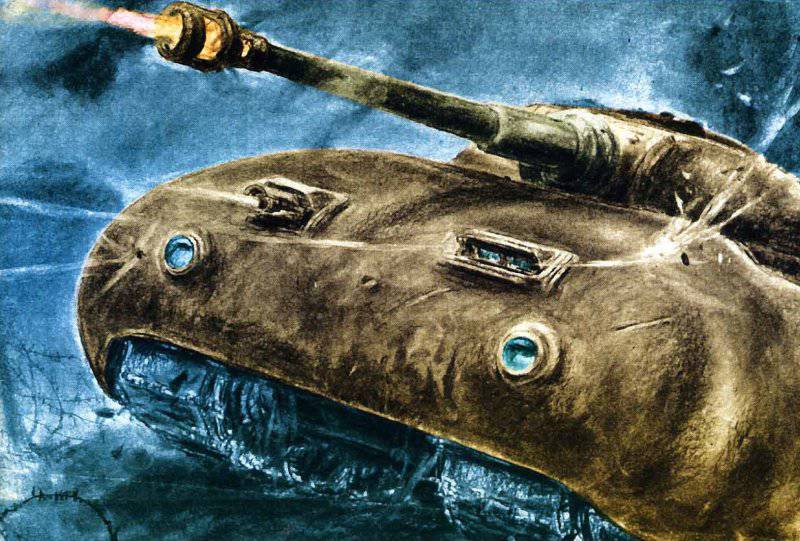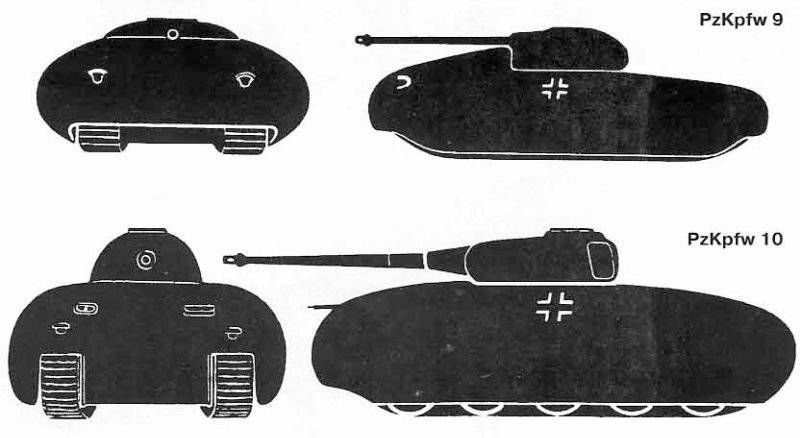PzKpfw 9 / 10 IS in German?
IN MARCH 1944 G. ON THE TABLE I.O. the head of the OGK NKTP Bera laid down a message with the following content:
The armament of the new tank is very strong and consists of a new 88-mm or 128-mm cannon with a long barrel and 3-x machine guns (1 anti-aircraft guns).
Presumably, the tank has a powerful aviation Daimler-Benz engine and a gas-electric transmission in the form of a transmission of the Ferdinand self-propelled guns ...
The armor protection of the new tank is not less than 150-200 mm from course fire angles ...
The main feature of the new German tank is the extensive use of large cast armor parts in the era construction of the hull and turret (there is information on the use in the tank design of the solid cast hull and turret), making it suitable for mass production and giving it a form that is very advantageous from the point of view of the propensity of armor-piercing shells to ricochet ... Currently, German enterprises are already leading the mass production of casting towers for a new heavy tank, which is expected in the fall ...
It is possible that the appearance of this tank was caused by the study of the German designers of cast turrets and hull parts of T-34, KV-1 tanks and our new heavy IS tank. "
Where this information was obtained from is unknown, how exact the exact date of its appearance in the USSR is unknown. Apparently, there are intertwined scattered data about the new Tiger Ausl V. sneaker better known under the name "Royal Tiger" (good, the first cars of this type actually carried the cast towers of F.Porsche construction), as well as rumors about an already tested "little mouse" and German propaganda editions second half of the war. Rather, it was all of this kind of fantastic patriotic publication in the Berliner Illustrator Zeitung (pictures from which are shown here}, and that was the source referred to in the above letter. It is unlikely that such a mythical project took place in Germany at the end war, but in the USSR, he caused some confusion.
In May, 1944, Mr. W. Behr receives a letter from NII-48:
...
3. We believe that the German industry mastered armor casting of towers and tank hulls is impossible due to the lack of the necessary range of alloying components in Germany at present, which is confirmed by studies of the chemical composition of rolled and cast armor tanks Tiger and Panther ...
6. German cast armor of high hardness of large thickness is not reliable protection against armor-piercing shells of large masses ... "
From this we can conclude that the head of the OGK NKTP apparently attracted armor specialists to study the scattered data on the new German tank with the "cast armor hull and turret", which was natural for those conditions.
And in June, 1944, pusg.mo, which features a "new heavy tank with cast armor," receives and the beginning. TsAKK V.Grabin:
On the performance report.
Shortly after the noted activity in the correspondence on the battlefields, new German heavy tanks really came out, which caused a surge of interest in their person, but they had almost nothing to do with what was expected, which was reflected in the research institute 18’s study of the Royal armor samples. tiger "next sentence:
It seemed you, the question was removed from the agenda, however, the T 9 and T-10 indices were still heard in the Soviet documents of that time. In the note accompanying the certificate of the most interesting samples of trophy combat equipment discovered on the territory of Germany, there was a small but very capacious postscript:
So the question is; "Was there a boy?" - Everyone can answer within their own personal opinions.


Information